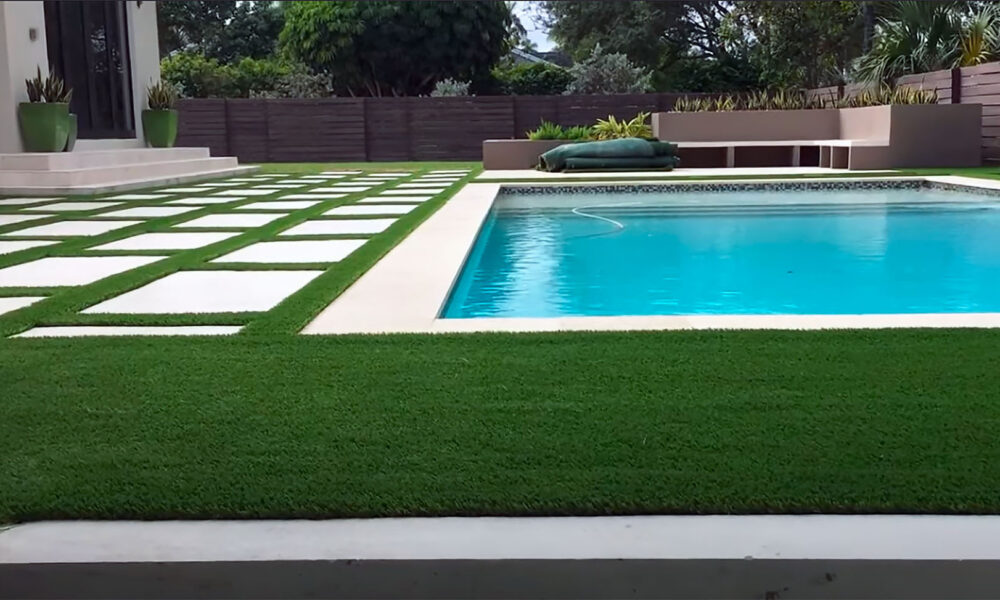Home Improvement
How to Install Artificial Turf around Pools

Nothing is better for cooling down and relaxing than jumping into the water and chilling in the sun. So if you have a pool in your backyard or plan to get one, consider yourself lucky. After deciding on the model you will install, you should also think about its surroundings.
There are different types of flooring to install around your swimming area. These are concrete pavements, decorative stone paths, wood bricks, grass, etc. The choice will depend on several factors, and your budget is one of them. But you should also have other things in mind, such as functionality and maintenance. In that case, artificial turf for around pools may be what you need.
Synthetic grass has many advantages as a surface around the swimming area. Besides being budget-friendly, this turf requires a minimum of maintenance, drains water very well, and is your best ally in keeping the pool surrounding clean. Installation is also easy if you follow a few simple guidelines.
Plan the Area
The initial step when arranging pool surroundings is to plan it. First, you must be clear about where the lawn will be. That will help you choose suitable materials, know their dimensions, as well how to install the grass.
First, you should also consider the location of the pool, as natural grass or artificial lawns usually follow the natural slope of the ground. Then, prepare the area by leveling the terrain and ensuring no drainage problems.
Prepare the Ground
The ground surrounding the pool should have adequate drainage, as water splashes can cause slippery surfaces. That’s usually the case with natural grass, as artificial turf is water-resistant and doesn’t absorb moisture. However, it still requires a proper drainage system.
So before installing artificial grass around a pool, it’s important to prepare the ground properly. Start with removing the existing lawn. Then, if necessary, use weed killers to destroy plant material down to the root. Just make sure you apply these agents in advance.
Next, you need to excavate the ground below the final height of the grass and ensure it has no drainage problems. Whether it’s soil or concrete, it should be slightly graded for the best water removal. But if it’s completely flat, you should drill drainage channels.
Finally, it’s the moment to install lawn edging. It can be anything from natural stone to lumbers, depending on the pool type, your exterior, and your landscape. But before doing that, make sure to tamp the ground. Here’s the direction on using tamper tools safely.
Put a Sub-Base
If you want to install artificial turf around a swimming pool, you must have a sub-base. It’s a soil layer about 6 to 8 inches thick. It allows water to drain and prevents the natural grass from expanding under your turf lawn. But its primary role is to protect the turf from heavy furniture and foot traffic damage.
There are a few different sub-base options. You can choose crushed miscellaneous bases, decomposed granite, or limestone chippings. In any case, a well-compacted sub-base will hold up well to foot traffic and impacts.
Regardless of the sub-base material, you need to place a light skim coat of sand over the sub-base. This will help make the turf firm. Some contractors even add a weed membrane underneath the sub-base. That comes in handy if you have pets that pee around. Plus, it traps weed.
The final step is to tap the sub-base material. But it shouldn’t be entirely compressed. Instead, go for 90% of compaction. The ground should be a bit airy not to trap moisture and allows faster drying of your swimming area.
Install Artificial Grass
Preparing the ground before installing artificial turf is a must because any mistakes you make in this step will show up in the finished product. Also, you must roll out the artificial turf at least 24 hours before installation. That’s enough time for artificial grass to acclimate and return to its normal shape.
You should lay the grass once the soil is completely dry. As turf comes in roles, you can use larger ones to cover larger areas. Plus, they’re suitable for cutting and fitting into curves and corners. At this point, you can also think about installing shock pads to make this area even softer.
Once you roll out artificial turf, ensure the edges overlap even a bit. That’s where you should secure these rolls with small nails. Also, do that alongside the edges outside the lawn perimeter.
More maintenance tips for artificial turf find in the following source:
https://www.livspace.com/in/magazine/7-ways-maintain-artificial-grass Choosing the right ground cover is crucial, as the area surrounding your pool will likely get a lot of traffic during the hot weather. That’s why you need a durable base like artificial turf to resist elements and wear and tear.